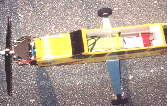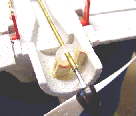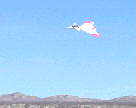 |
Flying High With Electric Power!
The Ampeer ON-LINE!
Fly the Future - Fly Electric! |
Site Table of Contents
| President: | Vice-President: | Secretary/Treasurer: |
| Ken Myers | Richard Utkan | Debbie McNeely |
| 1911 Bradshaw Ct. | 240 Cabinet | 4733 Crows Nest Ct. |
| Walled Lake, MI 48390 | Milford, MI 48381 | Brighton, MI 48116 |
| (248) 669-8124 | (248) 685-1705 | 810.220.2297 |
 | ||
| Board of Directors: | Board of Directors: | Ampeer Editor |
| Jim McNeely | Jeff Hauser | Ken Myers |
| 4733 Crows Nest Ct. | 18200 Rosetta | 1911 Bradshaw Ct. |
| Brighton, MI 48116 | Eastpointe, MI 48021 | Walled Lake, MI 48390 |
| (810) 220-2297 | (810) 772-2499 | (248) 669-8124 |
| Mailed Ampeer subscriptions are $10 a year US & Canada and $17 a year world wide. FREE on-line! | ||
| The Next Meeting: Date: Sat. & Sun, July 13 & 14 Place: Midwest R/C Society Field, 5 Mi. Rd, Northville Twp., MI Time: 8:00 a.m. | ||
|
From: David Hipperson email: ritzi@corplink.com.au Dear Ken, Reading about the upgrades and conversions in the February Ampeer made me
think about mine. An ideal aircraft, ripe for change is the Ridge Runt fitted with two 7.2V Speed 400's on 7 X 1000 mAh
NiCads and push on Gunther props. Mine weighs in at 950 grams exactly or 1 pound 15.5 ounces. From a hand launch, it fairly
zips away and is good with some sensible throttle management for 8 minutes.
If anyone wants more details they should feel free to E-mail me at ritzi@corplink.com.au Regards David Hipperson GWS Tiger Moth
Hi Ken, Greetings to all E-flyers. Just wanted to drop a line about my latest project which is a
GWS Tiger Moth. I replaced the plastic struts with 1/16" balsa, and instead of the plastic wheels I'm using Lyte tires from
New Creations. I am in the process of repainting the fuselage and wings, as sanding the mold nubs off removed paint. Using
masking tape when setting the wings dihedral is a no, no! It pulls the paint off so use instead low grip blue tape. I substituted the
GWS prop for an APC 9X6 electric slowfly. It will be using 8-350 NiCads for power.
Unionville Beaver
Hi Ken, Here is a shot of my just completed Unionville Hobby electric Beaver. I was
convinced to build it after hearing from Brade Trent and Tod Ablett who have built and flown this plane in British Columbia. I
have installed a Phasor 45/3 motor with the Phasor 40/3 Brushless speed controller and will be using a 10-7 Master Airscrew
electric prop. This plane weighs in at exactly 100 ounces. The motor puts out at least 65 watts per pound and I am hoping it will
fly as well as Brad and Tod's planes do.
Regards,
Upcoming E-FLI-OWA 2002 Saturday & Sunday, September 7 & 8
Receivers for Electric Flight I received an interesting email from Bob Larson in Las Vegas, NV. He was wondering if there is a database anywhere that lists current receivers that work well with electric flight systems. Since I am unaware of any such database, I thought that it might be a good idea to start one. He noted that he had problems with the FMA Quantum and new Airtronics Stylus. The problems were solved, in both cases, by swapping out those particular receivers for different ones. Nothing else was changed. Anyone else have any other data? NEW AIRPLANE RELEASE!
Firebat Electric ARF - standard version
A definite departure from the ordinary R/C flying scene - and a blast to fly! The Firebat has the exciting profile of a jet fighter, with a futuristic-looking canard design that's both unique and functional. A couple of tools, some epoxy adhesive and just 2-4 hours are all you need before you're ready for your first flight. And the Firebat delivers versatile performance, with clean, inexpensive electric power!
*NOTE: If flying in a public or residential area, please be sure there are no R/C flying locations within a 5 mile (8km) radius. This will eliminate the possibility of radio signal interference. Always fly in a safe and responsible manner, well clear of people, cars and buildings. Always launch plane skyward, away from people and obstacles. Smooth, quiet electric power is provided by the pusher-mounted Speed 400 motor;
two propellers are also included.
GPMA1400 Standard Version
GPMA1405 Deluxe Version! Includes speed control, battery pack and charger!
Cheap Electric R/C
Hi Electric Flyers, I recently visited the Wal-Mart in Port Huron, MI. From the TOY Department I
purchased the following item that you may wish to investigate.
(Thanks Merle, and especially thanks for sending the "hard copy" of the directions. Very interesting! KM) Ferrite Twin Motors on One Gearbox
Hi Ken, This is an follow up to some e-mails I sent you last October about a twin motor
gearbox. The work on the Kyosho Trainer 40 ARF and the Twin Gearbox was delayed by other projects, bad weather and
festivities, but it's finished, at last.
Happy landings and best regards.
 FOXBAT Review
The FOXBAT is an all foam kit from Germany and sold through Dymond
Modelsports of Oshkosh, WI. The plane features a Speed 480 motor with Gunther flexible prop. The motor is wired backwards
to be a pusher, and the prop is also reversed to achieve the most efficiency. Another intriguing feature is the live front canard
which acts as the elevator, allowing the rear ailerons to just be ailerons and not elevons. This saves one servo and eliminates the
requirement of employing a computer radio.
 For stability during this transient period I "constrained" the shaft inside a 1/2" plastic ring. I had to move the motor 6" forward from the specified rear mounting position to have any hope of balancing the model, and with the flight battery all the way forward in it's obvious mounting slot, only 1/2 oz of lead was required in the nose to achieve correct balance. The Rx and speed control are buried in the belly of the fuse, one on top of the other, and layers of aluminum foil were laid to try and eliminate any RF interactions among the parts. Finally, I ignored the plan of laying the Rx antenna in slots molded in the underside of the wings, and instead routed it a little through the forward fuse before exiting up to the tip of one of the tail fins. Several of us in the Condors had had "range" problems with a similar popular foam ARF that we concluded were most likely due to improper antenna placement. That's another story, and if I ever do find that model in the rattlesnake-infested bamboo downwind of our field, I will do further tests! From experience with a similar moveable-canard model I was somewhat skeptical of how the canards would perform on the FOXBAT. But I needn't have worried, as the first flight at the model field of Edwards AFB on Feb 21 went without a hitch. Once trimmed, and adding some exponential to the overly sensitive ailerons, the FOXBAT flew like the Russian supersonic fighter of its namesake. Beautiful against the clear winter sky of the high California desert. Since this is a hand-launched model it's best to land it on grass, but the hard lakebed surface at Edwards hardly added a pimple to this smooth flyer. This is the best $59 kit you will find anywhere….get one for yourself! (Sure looks like the Firebat presented earlier. KM)  X-250 Comment & Schottky Diode
Hello Ken, I flew the modified X-250 with semi-symmetrical airfoil, and dihedral (aileron
version). 100% improvement over the standard wing. Inverted flight is now as easy as right side up. A young modeler took
controls of it and said its the easiest model he has flown.
Thank you
A diode is a two-terminal electronic device that permits current flow mostly in only one direction. Most diodes are semiconductor devices. A diode has a low resistance to electric current in one direction and a high resistance to it in the reverse direction. Its purpose is to keep any electricity generated by the motor, yes it generates as well as uses electricity, from feeding back into the speed controller and damaging it. Some controllers have them built in, or with some of the smaller or less expensive ones, they require the user to install it across the motor terminals. More on Flight Logs
There is a flight logbook at:
www.lammers.ca/FlightLog
Perhaps it is the one Edward Russell was looking for.
New Product Announcement - The Ultimate BEC
Hi Ken, I just wanted to let you know about our new product, "The Ultimate BEC."
Best Regards,
This is a very interesting product, and I encourage you to visit the site to check out the possibilities. KM P47N
After a long tale of woes including changing positions, the P47 has flown. Here's the info: Top Flight Gold Edition P47 modified to "N" standards by stretching the wing three inches at the root, squaring the wing tips, adding the bubble canopy and the unique rounded dorsal fin. Power is a MaxNeo geared 3.53/1 on 21 cells using a 14/10 prop (APCe and Zinger so far) 34 amps static; weight ready to fly 10.5 lbs. Robart retracts. Color scheme is based on my cousin's (Col. Harrisont R. Thyng) command plane based on Ie Shima in 1945 (413th FG, squadron and section unknown) Flight summary. Take off is much better with flaps (don't ask me how I learned that!). Roll on short
grass was about 75', climb out was scale like at about a 30 degree angle. The only trim correction needed was a substantial
amount of down elevator (tests suggest a slightly rearward c/g and a need for down thrust on the motor). Once speed was built
up it appears that e-calc was right on. Nice big round loops were possible from level flight. Rolls were a sight to see ---
perfectly scale-like.

Airplane Rating: EMBAT
Hi Ken, Just found the EFO web site. I'll be back often. Here's some notes on planes I have for your Airplane Ratings. Plane: Aveox EMBAT
With this set-up the EMBAT goes over 85 MPH during 5 to 6 minute flights with
unlimited vertical. Very aerobatic, but doesn't track quite like an Electrostreak or pattern plane. Reflexing ailerons up during
landings helps a lot or you will need lots of room without a good headwind.
Plane: ESO Speed by JR Models
This ARF hotliner sailplane has a fiberglass fuselage and a very strong obechi over
foam one piece wing with a reinforced spar. It will climb at a 75 degree angle to a speck in the sky in about 15 seconds. From
that altitude it is a thrill to split S towards the ground at 100 MPH plus speeds and use the stored-up energy to do power-off loops
and rolls. The motor/battery combination is good for 5 climbs. This plane also makes a very fast slope soarer in winds over 20
MPH. It will only thermal in strong lift.
Multiplex Combat Pico-Jet ARF
This inexpensive, fast, durable, easy to build, maneuverable model turns heads at the field. The prop has a great buzzing sound that just adds to the models appeal. My only problem is that the press-on props tend to fall off after a while. Get the combat version of this plane with more flexible foam. The non-combat plane tends to crack, especially in the nose area, after hard landings. Just a brief suggestion. I would like to see the date when the rating was submitted
by an individual. I was tempted to email my experiences with their planes to the reviewers to compare notes, but wouldn't if the
review has been posted for a while.
Concerning Serial Packs
Hi Ken, That was a good article and very clear (April 2002 Ampeer KM). The one
thing that might have made it better would be to mention that instead of plugging a black and red connector together, it is more
correct to use a short piece of yellow wire (same gage) with yellow Sermos connectors on it. Then use it to connect the two
packs together. That allows the rule "Never plug a black connector into a red one" rule to hold true. Also it's a very visible reminder that there is a special connection here.
VTOL Electric Ducted Fan Model Nears Completion
Hello Ken, You may remember I mentioned that I was attempting to build an EDF VTOL scale
model of the Boeing X32b Joint Strike Fighter. Well....

The numbers go as follows… 3 x 86 mm diameter 6 bladed fans (Wemotec HW620's) run by Plettenberg brushless HP220/30 A3 S P4 motors. Each motor can handle 1KW+ pity the cells cannot. Cells are 24 x 2400mAh matched and zapped AUW expected to be 9 lb. Current draw - 75A (25A from each motor) Duration at hover approximately 2 minutes The model includes 3 pizo gyros for control of the 3 axis, pneumatic micro spring air retracts with scale sequenced UC doors. Working scale hatches for hover mode, and a really neat way to hide the 2 rear fans from view when hovering. I will attempt to finish the model over the Easter break and let you know how I get on with the initial hover testing. $2000 of kit (at least) so don’t rush me. My URL www.awatson1.fsnet.co.uk Dr Andrew H. Watson - Plymouth UK P.S. I'm actually wearing my MSU t-shirt which I got after staying there for a few months while doing my pHd. Lansing isn’t it? (You bet. Only 1 hour west of here. KM) I was there in September and October. Overnight the weather dropped about 25 degrees C, sunburn to frostbite....geezze! R/C Electric Powered Interactive Update
Hi, I now have kits and plans of my latest creation I call the Electro-Star 600. This is a redesign of the Electro-Star 15. After a lot of thinking of new ways of lightning this plane up, I was able to cut 8 oz from the original weight of 72 oz. Electro-Star 600 Specs:
You can buy the Electro-Star kit or plans on my Online Store on
www.rcepi.com
Aircraft Covering Material
Hi Builders and Flyers, Wish to share another bit of information which some have...some have not. (Sorry, I don’t know where Merle got this info. KM)
I checked the Web trying to find this table, but couldn’t. It seems correct,
as I have some of these numbers already. For those of us not on the metric system: to find the number of ounces per
sq.ft. divide the weight in grams from above by 305. If you want ounces per sq.yd., divide by 33.9.
To Reach Ken Myers, you can land mail to the address at the top of the page. My E-mail
address is:
KMyersEFO@aol.com
|





